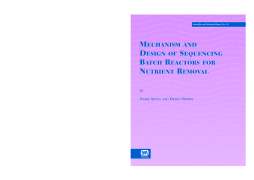
BOOK
Mechanism and Design of Sequencing Batch Reactors for Nutrient Removal
Derin Orhon | Ozlem Karahan | G. E. Zengin | Oliver Olsson | Melanie Bauer
(2005)
Additional Information
Book Details
Abstract
The sequencing batch reactor (SBR) is perhaps the most promising and viable of the proposed activated sludge modifications today for the removal of organic carbon and nutrients. In a relatively short period, it has become increasingly popular for the treatment of domestic and industrial wastewaters, as an effective biological treatment system due to its simplicity and flexibility of operation. Mechanism and Design of Sequencing Batch Reactors for Nutrient Removal has been prepared with the main objective to provide a unified design approach for SBR systems, primarily based on relevant process stoichiometry. Specific emphasis has been placed upon the fact that such a unified design approach is also by nature the determining factor for the selection of the most appropriate cyclic operation scheme, the sequence of necessary phases and filling patterns for the particular application. The proposed basis for design is developed and presented in a stepwise approach to cover both organic carbon and nutrient removal, domestic and industrial wastewaters, strong and specific wastes. The merits of model simulation as an integral complement of process design, along with performance evaluation of SBR models are also emphasized. Scientific and Technical Report No. 19
Table of Contents
| Section Title | Page | Action | Price |
|---|---|---|---|
| 1.1. HISTORICAL PERSPECTIVE | xiii | ||
| 1.2. CURRENT EXPERIENCE | xv | ||
| 1.2.1. Basic and Applied Research | xv | ||
| 1.2.2. Full-scale Application | xvii | ||
| 1.3. NEED FOR MODELING AND A UNIFIED BASIS FOR DESIGN | xvii | ||
| 1.3.1. The concept of process stoichiometry and modelling | xviii | ||
| 1.3.2. Objective and Scope | xix | ||
| 2.1. GENERAL DESCRIPTION | xxi | ||
| 2.1.1. Cycle Frequency (m) | xxii | ||
| 2.1.2. Nominal Hydraulic Retention Time (HRT) | xxii | ||
| 2.1.3. Duration of Phases in a Cycle | xxiii | ||
| 2.1.4. Duration of Periods in a Process Phase | xxiii | ||
| 2.1.5. Number of Tanks | xxiv | ||
| 2.1.6. Sludge Retention Time (SRT) | xxiv | ||
| 2.2. REACTOR HYDRAULICS | xxv | ||
| 2.3. PROCESS OPTIONS | xxviii | ||
| 2.3.1. Carbon Removal and Nitrification | xxviii | ||
| 2.3.2. Nutrient Removal | xxix | ||
| 2.4 EFFECTS OF FILLING AND AERATION PATTERNS ON POPULATION DYNAMICS | xxxiv | ||
| 3.1. BASIC PRINCIPLES | xxxv | ||
| 3.2. SELECTION OF SRT | xxxvii | ||
| 3.2.1 Effluent Quality | xxxviii | ||
| 3.2.2. Excess Sludge Production and Reactor Biomass | xxxviii | ||
| 3.3. SINGLE TANK DESIGN PRINCIPLES | xxxix | ||
| 3.4. AERATION SYSTEM DESIGN PRINCIPLES | xlii | ||
| 3.5. PROCESS DESIGN | xlv | ||
| 3.5.1. Design Procedure | xlv | ||
| 3.5.2. SBR Equipment and the Practical Aspects of SBR Design | xlviii | ||
| 3.5.2.1. Factors Affecting Reactor and Equalization Tank Dimensioning | xlviii | ||
| xlix | |||
| 3.5.2.2. Mixing/Aeration Equipment Used in SBRs | xlix | ||
| 3.5.2.3. Other SBR Equipment | li | ||
| 3.5.2.4. Control of SBR Systems | lii | ||
| 3.5.3. Design Example | liii | ||
| 4.1. BASIC PRINCIPLES FOR NITROGEN REMOVAL | lviii | ||
| 4.1.1. Nitrogen Mass Balances | lix | ||
| 4.1.2. Carbon and Nitrate Limitations | lxi | ||
| 4.1.3. Selection of Process Option | lxii | ||
| 4.2. UNIFIED DESIGN PROCEDURE FOR NITROGEN REMOVAL | lxiii | ||
| 4.2.1. SBR Design for Pre-denitrification | lxv | ||
| 4.2.2. SBR Design for Step Feeding | lxix | ||
| 4.2.3. SBR Design for Intermittent Aeration | lxxi | ||
| 4.3. DESIGN CONSIDERATIONS FOR PHOSPHORUS REMOVAL | lxxii | ||
| 4.3.1. Mechanism of Biological Phosphorus Removal | lxxiii | ||
| 4.3.2. Factors Affecting EBPR | lxxiii | ||
| 4.3.2.1. Wastewater Characteristics | lxxiii | ||
| 4.3.2.2. System Parameters | lxxiv | ||
| 4.3.2.3. Environmental factors | lxxiv | ||
| 4.3.3 EBPR without Nitrogen Removal | lxxv | ||
| 4.3.4. Simultaneous Nitrogen and Phosphorus Removal | lxxv | ||
| 4.4. RETROFIT OF EXISTING SBR PLANTS | lxxviii | ||
| 5.1. NEED FOR SIMULATION MODELS | lxxxi | ||
| 5.2. PERFORMANCE EVALUATION FOR COD REMOVAL | lxxxiii | ||
| 5.3. PERFORMANCE EVALUATION FOR NITROGEN REMOVAL | lxxxviii | ||
| 5.3.1. Evaluation of Simulation Results | lxxxix | ||
| 5.3.1.1. Effect of NDP Prediction on Effluent Nitrate Nitrogen | xci | ||
| 5.3.1.2. Effect of Aeration Intensity | xcii | ||
| 5.3.1.3. Effects on Effluent Ammonium Nitrogen | xciii | ||
| 5.3.2. Comparison of Process Options | xciii | ||
| 5.4. PERFORMANCE EVALUATION FOR PHOSPHORUS REMOVAL | xciv | ||
| 5.4.1 Effect of System Parameters | xciv | ||
| 5.4.2. Effect of Wastewater Composition | xcvii | ||
| 5.5. EVALUATION OF SIMULTANEOUS NITROGEN AND PHOSPHORUS REMOVAL PERFORMANCES | c | ||
| 5.6. EVALUATION OF DYNAMIC CONDITIONS | ci | ||
| Nomenclature | x |
